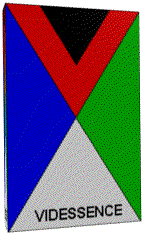Digital photography may require a different kind of lighting (Part II).
Between the evolution of "tungsten" filters, improvements in the software, and new designs for lamps, everything is still in flux. This particular note is just to alert digital photographers to do careful testing of lighting before they accept an assignment with their fancy new digital system. I wholeheartedly recommend going digital; the Better Light large format system and most medium format digital backs are clearly superior to most aspects of using 120 or 220 film, but look before you leap. For example, you can't use strobes with large format digital scanning backs. Some older strobes may not be accurate enough for 16-shot medium format backs from Sinar or Imacon-Hasselblad.
Since the FLAAR. Photo Archive staff does not sell any brand or class of lighting, we can remain neutral in the war of standards and brand names that is breaking out as companies realize there is a gold rush to produce equipment compatible with the new digital camera systems.
We tested HMI and fluorescent lighting while establishing a digital photography training program for the University of Malta, Malta Centre for Restoration. These reports are now available in the various FLAAR courses (easy to access since these are on-line programs)..
 In the meantime, the use of fluorescent lighting is making considerable inroads in digital photography as studios realize it is a cost-effective way to do lighting for the new era in photography. The new fluorescent lighting is not the old fashioned kind which was instant death to color balance when you used film. The new SRGB tubes are specially made for professional photography. Furthermore, they are friendly to CCD electrical preferences.
In the meantime, the use of fluorescent lighting is making considerable inroads in digital photography as studios realize it is a cost-effective way to do lighting for the new era in photography. The new fluorescent lighting is not the old fashioned kind which was instant death to color balance when you used film. The new SRGB tubes are specially made for professional photography. Furthermore, they are friendly to CCD electrical preferences.
Strobe or flash cannot be used on the high-end large format digital systems such as Dicomed Studio Pro or Better Light. These cameras record such precise detail, however, that being unable to use strobe is still worthwhile.
Whether HMI lighting can evolve to replace strobe and tungsten remains to be seen. Technical reports vary widely in their opinions whether HMI lighting is ideal for digital. Part of the problem is that a test lab may see digital artifacts with a magnifying glass that will not show up on a normal picture unless you enlarge it to cover the side of the Empire State Building.
In Europe Hedler gets around the problem of heat from tunsten lightin with built in fans. We need to test our Hedler units to ascertain whether the fan leaves a digital imprint on the image from a CCD scanning back. Hedler and other leading studio light manufactuers are aware of the new requirements of digital studios and are designing special new lighting systems for high-end digital studios.
What will professional photographers be using in the year 2006? This is an exciting period of history to experience. Check out our review of NorthLight Sun Spots and other lighting for large format digital photography.
Most recently updated July 4, 2005.